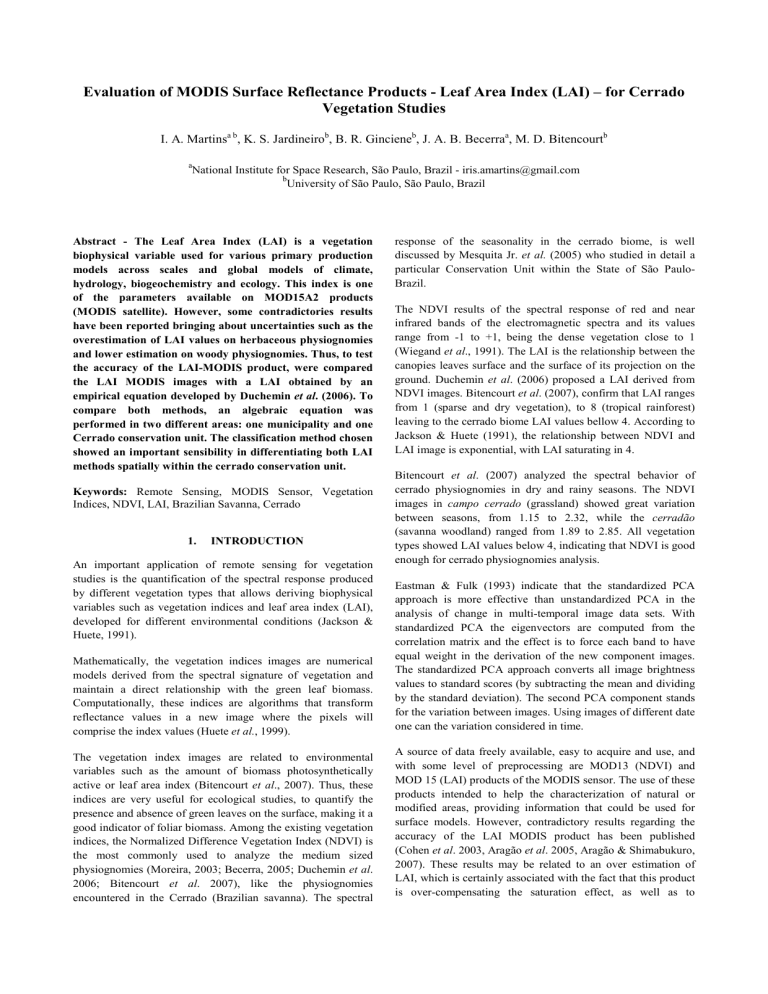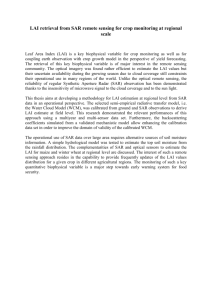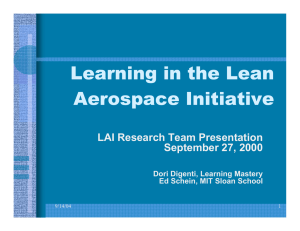Evaluation of MODIS Surface Reflectance Products - Leaf Area Index... Vegetation Studies

Evaluation of MODIS Surface Reflectance Products - Leaf Area Index (LAI) – for Cerrado
Vegetation Studies
I. A. Martins a b
, K. S. Jardineiro b
, B. R. Ginciene b
, J. A. B. Becerra a
, M. D. Bitencourt b a
National Institute for Space Research, São Paulo, Brazil - iris.amartins@gmail.com b
University of São Paulo, São Paulo, Brazil
Abstract - The Leaf Area Index (LAI) is a vegetation biophysical variable used for various primary production models across scales and global models of climate, hydrology, biogeochemistry and ecology. This index is one of the parameters available on MOD15A2 products
(MODIS satellite). However, some contradictories results have been reported bringing about uncertainties such as the overestimation of LAI values on herbaceous physiognomies and lower estimation on woody physiognomies. Thus, to test the accuracy of the LAI-MODIS product, were compared the LAI MODIS images with a LAI obtained by an empirical equation developed by Duchemin et al . (2006). To compare both methods, an algebraic equation was performed in two different areas: one municipality and one
Cerrado conservation unit. The classification method chosen showed an important sensibility in differentiating both LAI methods spatially within the cerrado conservation unit.
Keywords: Remote Sensing, MODIS Sensor, Vegetation
Indices, NDVI, LAI, Brazilian Savanna, Cerrado
1.
INTRODUCTION
An important application of remote sensing for vegetation studies is the quantification of the spectral response produced by different vegetation types that allows deriving biophysical variables such as vegetation indices and leaf area index (LAI), developed for different environmental conditions (Jackson &
Huete, 1991).
Mathematically, the vegetation indices images are numerical models derived from the spectral signature of vegetation and maintain a direct relationship with the green leaf biomass.
Computationally, these indices are algorithms that transform reflectance values in a new image where the pixels will comprise the index values (Huete et al.
, 1999).
The vegetation index images are related to environmental variables such as the amount of biomass photosynthetically active or leaf area index (Bitencourt et al ., 2007). Thus, these indices are very useful for ecological studies, to quantify the presence and absence of green leaves on the surface, making it a good indicator of foliar biomass. Among the existing vegetation indices, the Normalized Difference Vegetation Index (NDVI) is the most commonly used to analyze the medium sized physiognomies (Moreira, 2003; Becerra, 2005; Duchemin et al .
2006; Bitencourt et al . 2007), like the physiognomies encountered in the Cerrado (Brazilian savanna). The spectral response of the seasonality in the cerrado biome, is well discussed by Mesquita Jr. et al.
(2005) who studied in detail a particular Conservation Unit within the State of São Paulo-
Brazil.
The NDVI results of the spectral response of red and near infrared bands of the electromagnetic spectra and its values range from -1 to +1, being the dense vegetation close to 1
(Wiegand et al ., 1991). The LAI is the relationship between the canopies leaves surface and the surface of its projection on the ground. Duchemin et al . (2006) proposed a LAI derived from
NDVI images. Bitencourt et al . (2007), confirm that LAI ranges from 1 (sparse and dry vegetation), to 8 (tropical rainforest) leaving to the cerrado biome LAI values bellow 4. According to
Jackson & Huete (1991), the relationship between NDVI and
LAI image is exponential, with LAI saturating in 4.
Bitencourt et al . (2007) analyzed the spectral behavior of cerrado physiognomies in dry and rainy seasons. The NDVI images in campo cerrado (grassland) showed great variation between seasons, from 1.15 to 2.32, while the cerradão
(savanna woodland) ranged from 1.89 to 2.85. All vegetation types showed LAI values below 4, indicating that NDVI is good enough for cerrado physiognomies analysis.
Eastman & Fulk (1993) indicate that the standardized PCA approach is more effective than unstandardized PCA in the analysis of change in multi-temporal image data sets. With standardized PCA the eigenvectors are computed from the correlation matrix and the effect is to force each band to have equal weight in the derivation of the new component images.
The standardized PCA approach converts all image brightness values to standard scores (by subtracting the mean and dividing by the standard deviation). The second PCA component stands for the variation between images. Using images of different date one can the variation considered in time.
A source of data freely available, easy to acquire and use, and with some level of preprocessing are MOD13 (NDVI) and
MOD 15 (LAI) products of the MODIS sensor. The use of these products intended to help the characterization of natural or modified areas, providing information that could be used for surface models. However, contradictory results regarding the accuracy of the LAI MODIS product has been published
(Cohen et al . 2003, Aragão et al . 2005, Aragão & Shimabukuro,
2007). These results may be related to an over estimation of
LAI, which is certainly associated with the fact that this product is over-compensating the saturation effect, as well as to
contamination by clouds of the images used to compose the LAI mosaic, which decreases the average value of this index to be calculated by the product algorithm (Aragão & Shimabukuro,
2007).
Thus, it is essential to evaluate the uncertainty of the MOD15, in order to improve its accuracy. Moreover, the index to be analyzed is a critical variable for estimating the carbon and water fluxes in the biomes, as well as to understand their responses to the effects of climate change.
This paper aims to analyze the efficiency of the LAI MODIS product, in relation to an empirical equation developed by
Duchemin et al . 2006, in an area of the Cerrado (Brazilian savanna) domain.
2.
METHODOLOGY
The study area is located in Santa Rita do Passa Quatro (SRPQ)
Municipality (21°37’S, 47°37’W). It’s an area of 75491 ha under cerrado domain and located in São Paulo State, Brazil.
Figure 1 represents the location and extent of the cerrado domain in Brazil and São Paulo, as well as the study area.
Figure 3. Flowchart showing the methodological steps for comparison between two LAI products (LAI MODIS and LAI
Duchemin et al.
2006).
The results of that paper is expected to be obtained by classifying the final image generated from the subtraction processed between LAI MODIS 2 nd
PC and LAI Duchemin 2 nd
PC, which refers to the variation of attributes between these images. Values near zero indicate that were no changes in pixel values (LAI values are similar between both methods), the negative values indicate that the LAI Duchemin showed higher values than LAI MODIS for the same pixel while the positive values indicate that the LAI Duchemin showed lower values than LAI MODIS for the same pixel. Thus, the image was classified in three classes: Class 1 (negative values), Class 2
(values near zero) and Class 3 (positive values).
3.
RESULTS AND DISCUSSION
Table 1 shows the percentages of pixels presented in each area.
These percentages were obtained from the classification of the final image according to the criteria: Class 1 (negative values),
Class 2 (values near zero) and Class 3 (positive values). The final image refers to the attributes variation presented in the LAI
MODIS and LAI Duchemin images used for analysis.
For the location of SRPQ, 58.2% of the pixels are in class 1
(negative values), while 41.3% are in class 2 (values near zero).
Only 0.5% are in class 3 (positive values). Thus, we affirm the
LAI MODIS is underestimating the LAI values in relation to
LAI Duchemin. For PG, 30.8% of the pixels are in class 1 and
69.2% are in class 2. In this location were not detected pixels in class 3. Thus, we affirm that most of the LAI MODIS values are similar to LAI Duchemin values. However, there is some underestimation of MODIS LAI values compared to LAI
Duchemin.
Table 1. Percentage of pixels obtained for each area. SRPQ =
Santa Rita do Passa Quatro Municipality; PG = Pé-de-Gigante
Conservation Unit
Class Number
( final image )
SRPQ PG
1
2
3
58,2
41,3
0,5
30,8
69,2
0,0
When the two locations (SRPQ and PG) are compared, we found that there are differences regarding the distribution of pixels between classes. Certainly these differences are associated with the spatial scale and the land cover. The SRPQ is an agricultural municipality (mostly sugar-cane and orange) and PG is a conservation unit with xenomorphic vegetation type
(all cerrado physiognomies with dry season occurring from June to September).
Our results allow a simple evaluation of the LAI MODIS performance in areas under cerrado domain. The next step is to determine where is located the uncertainty about the values acquired by the LAI MODIS. The algorithm that calculates the
LAI MODIS basically has two input variables: the reflectance surface images obtained by the sensor (red and near infrared bands) and the global biome map, generated from the analysis and classification of MODIS images acquired in 2000 (Wang et al ., 2001). Therefore, the LAI values are estimated by a lookup-table (LUT) system that uses an inverted three-dimensional radiative transfer model (Knyazikhin et al ., 1998). The algorithm, thus, will compare the observed and modeled reflectance for a group of different vegetation and soils types, i.e., it assigns a LAI value through the reflectance of a given pixel and the type of biome that the pixel belongs. However, the main algorithm can fail and in this case, a secondary algorithm will calculate the LAI using the NDVI image and the global biome map, also by the LUT system (Myneni et al ., 1997).
There are two main factors that affect the quality of LAI
MODIS: uncertainties related to the input variables or related to the models that support the algorithms (Tan et al ., 2005).
In this paper we use only MODIS images (LAI MODIS and
NDVI MODIS), thus we can infer if the main input variable
(reflectance images) could be a problem in estimating the LAI values. However, with the results obtained here it was possible to determine that was no difference between values of LAI estimated by LAI MODIS and LAI Duchemin, that is a product of a NDVI MODIS image. This suggests that the problem is not related to the reflectance images, but associated to the global biome map or to the inverted three-dimensional radiative transfer model.
4.
CONCLUSIONS
In this paper was possible to ascertain an underestimation of the
LAI values obtained in MOD15 product. This problem may be associated to the global biome map or to the inverted threedimensional radiative transfer model. Analyses seeking to reassess the quality of the global biome map, and the inverted three-dimensional radiative transfer model can account this low performance of the MOD15 product or even help the development of an adjustment mechanism for this product.
5.
REFERENCES
Aragão, L.E., & Shimabukuru, Y.E. (2007). Avaliação do índice de área foliar da Amazônia . In Rudorff, B.F.T.; Shimabukuru,
Y.E; Ceballos, J.C. O sensor modis e suas aplicações ambientais no Brasil. São José dos Campos: A. Silva Vieira Ed., p.221-236.
Bitencourt, M. D., Mesquita JR, H. N., Kuntschik, G., Rocha,
H. R., & Furley, P. A. (2007). Cerrado vegetation study using optical and radar remote sensing: two Brazilian case studies.
Canadian Journal of Remote Sensing , v.33, p.468-480.
Cohen, W.B., Maiersperger, T.K., Yang, Z., Gower, S.T.,
Turner, D.P., Ritts, W.D., Berterretche, M., & Running, S.W.
(2003).Comparisons of land cover and LAI estimates derived from ETM+ and MODIS for four sites in North America: a quality assessment of 2000/2001 provisional MODIS product.
Remote Sensing of Environment , v.88, p.233-255.
Duchemin, B., Hadri, R., Erraki, S., Boulet, G., Maisongrande,
P., Chehbouni, A., Escadafal, R., Ezzahar, J., Hoedjes, J.C.B.,
Kharrou, M.H., Khabba, S., Mougenot, B., Olioso, A.,
Rodriguez, J.C., & Simonneaux, V. (2006). Monitoring wheat phenology and irrigation in Central Morocco: On the use of relationships between evapotranspiration, crops coefficients, leaf area index and remotely-sensed vegetation indices.
Agricultural Water Management , v.79, p.1–27.
Eastman, J.R., & Fulk, M. (1993). Long sequence time series evaluation using standardized principal components.
Photogrammetric Engineering & Remote Sensing , v.59, n.6, p.991-996.
Eastman, J.R. (2006). IDRISI Andes . Clark University
Laboratory, Clark University, Worcester, Pennsylvania.
Huete, A., Justice, C. & Van Leeuwen, J.D. (1999) MODIS
Vegetation Index (Mod 13) Algorithm Theoretical Basis
Document Version 3. University of Arizona, Tucson - USA.
Goeffrey, M. H. (1997). Detecting change in grasslands using measures of spatial dependence with Landsat TM data. Remote
Sensing of Environment , v.46, n.4, p.223-234.
Jackson, R.D., & Huete, A.R. (1991). Interpreting vegetation indices. Preventive veterinary medicine , v.11, p.185-200.
Knyazikhin, Y., Martonchik, J.V., Myneni, R.B., Diner, D.J.,
Running, S.W. (1998). Synergistic algorithm for estimating vegetation canopy leaf area index and fraction of absorbed photosynthetically active radiation from MODIS and MISR data. Journal of Geophysical Research , v.103, p.32257-32275.
Mesquita Jr., H.N.; Bitencourt, M.D.; Rocha, H.R. (2005)
Sazonalidade da vegetação e Balanço de radiação. In: Vânia
Regina Pivello & Elenice Mouro Varanda (Orgs.) Cerrado Péde-Gigante: ecologia e conservação – Parque Estadual de
Vassununga - São Paulo: São Paulo, SMA, p. 163-172.
Myneni, R.B.; Nemani, R.R., Running, S.W. (1997). Estimation of global leaf area index and absorbed par using radiative transfer models. IEEE Transaction on Geoscience and Remote
Sensing , v.35, p.1380-1393.
Moreira. M.A. (2003). Fundamentals of remote sensing and application methodologies . Viçosa: UFV.
Tan, B., Hu, J., Huang, D., Yang, W., Zhang, P., Shabanov, N.
V., Knyazikhin, Y., Myneni, R.B. (2005). Assessment of the broadleaf crops Leaf Area Index product from the Terra
MODIS instrument. Agricultural and Forest Meteorology, v.135, n.1-4, p.124-134.
Wang, Y., Tian, Y.; Zhang, Y., El-Saleous, N., Knyazikhin, Y.,
Vermote, E., Myneni, R.B. (2001). Investigation of product accuracy as a function of input and model uncertainties: case study with SeaWiFS and MODIS LAI/FPAR Algorithm.
Remote Sensing of Environment, v.78, p.296-311.
Wiegand, C.L., Richardson, A.J., & Escobar, D.E. (1991).
Vegetation indices in crop assessment. Remote sensing of environment , v.35, p.105-119.




